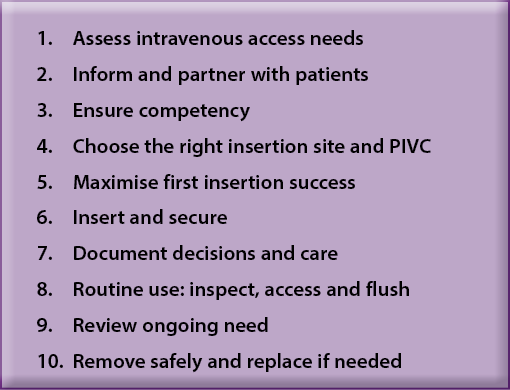Volume 7 Issue 2
From the Deputy Editor
Gillian Ray-Barruel
For referencing Ray-Barruel G. From the Deputy Editor. Vascular Access 2021; 7(2):5-6.
DOI https://doi.org/10.33235/va.7.2.5-6
How to incorporate the new Management of Peripheral Intravenous Catheters (PIVCs) Clinical Care Standard (CCS) into practice
The Australian Commission on Safety and Quality in Health Care launched the long-awaited Management of Peripheral Intravenous Catheters (PIVCs) Clinical Care Standard (CCS) in May 2021.1 This national standard for short PIVC insertion and management is based on a review of national and international evidence-based practice guidelines2 and has been endorsed by a panel of vascular access and infection control experts from across Australia. Using the PIVC CCS to monitor and improve PIVC insertion and management at a local level helps organisations meet some of the accreditation requirements of the National Safety and Quality Health Service (NSQHS) Standards.3
The new PIVC CCS provides straightforward, evidence-based guidance for clinicians. It also describes the care that patients should expect to receive if they have a PIVC inserted during a hospital stay. The PIVC CCS comprises 10 evidence-based quality statements (Figure 1) and a set of indicators for safe and appropriate care. The Commission has also provided supporting documents on their website (safetyandquality.gov.au/PIVC-CCS):

Figure 1. Pivc quality statements
- Clinician fact sheet
- Health service organisations fact sheet
- Consumer fact sheet
- Patient information – how to look after your cannula
- IV-WISE discussion tool.
Here are some suggestions for incorporating the PIVC CCS into local practice in your own health service.
- Distribute electronic copies of the PIVC CCS to hospital nursing and medical executives, quality and safety committees, infection prevention and management committees, vascular access professionals, nurse unit managers, nurse practitioners, nurse educators, medical educators, and anyone else who needs to be informed.
- Ask committee members to identify local clinical champions who will help drive enthusiasm and provide clinical staff education.
- Review your local PIVC guidelines to ensure they comply with the PIVC CCS quality statements and indicators.
- Review your local PIVC audit tools to ensure they meet the PIVC CCS indicators.
- Conduct point prevalence surveys of patients with a PIVC in situ to identify gaps in clinical practice and prioritise areas for quality improvement initiatives.
- Share results of point prevalence surveys with all health professionals involved in patient care.
- Provide staff education on the PIVC CCS, and encourage questions and discussion.
- Be creative and encourage staff to engage with the standards and PIVC practice audits.
- Promote the PIVC CCS in your local hospital newsletter, staff forums and ward meetings.
- Distribute the PIVC CCS resources to wards, including printed copies of the standards and laminated posters for staff tea rooms and notice boards.
- Engage patients in the process. Display laminated posters of the patient PIVC resources in prominent ward areas and visitors’ waiting rooms.
- Include patents in clinical handover processes when discussing invasive devices.
If you have any questions about PIVC best practice, or more suggestions on how to translate the PIVC CCS into clinical practice, I encourage you to get in touch.
Gillian Ray-Barruel RN, PhD, MACN
Author(s)
Gillian Ray-Barruel RN, PhD, MACN
References
- Australian Commission on Safety and Quality in Health Care. Management of peripheral intravenous catheters clinical care standard [Internet]. Sydney: ACSQHC; 2021. Available from https://www.safetyandquality.gov.au/publications-and-resources/resource-library/management-peripheral-intravenous-catheters-clinical-care-standard
- Keogh S, Mathew S, Alexandrou E, Bulmer A, Cooke M, Coventry L, et al. Peripheral intravenous catheters: a review of guidelines and research [Internet]. Sydney: ACSQHC; 2019. Available from https://www.safetyandquality.gov.au/publications-and-resources/resource-library/peripheral-intravenous-catheters-review-guidelines-and-research
- Australian Commission on Safety and Quality in Health Care. National safety and quality health service standards [Internet] 2nd ed. Sydney: ACSQHC; 2017. https://www.safetyandquality.gov.au/standards/nsqhs-standards
